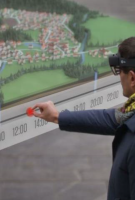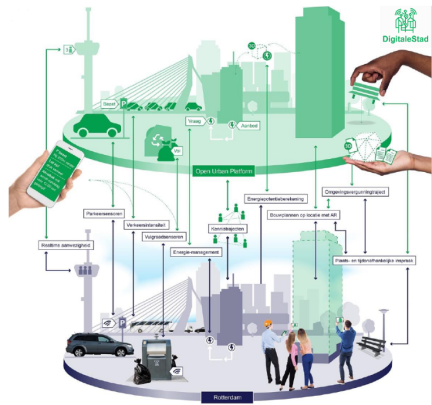The webinar “Improving the use of location intelligence in Smart Spaces” organised by ELISE on 16 December 2021 presented the experiences of innovative digital solutions from three smart cities and analysed how location intelligence is exploited in Smart Spaces using the Smart Space Benchmarking Framework.
A Smart Space can be defined as a combination of physical and digital environments in which people and technology-enabled systems interact in dynamic, inter-connected and intelligent ecosystems.
In this context, the Smart Space Benchmarking Framework tests location intelligence in a Smart Space on four dimensions:
- location intelligence contribution to public value;
- role of location data and public sector actions;
- location data interoperability and exchange;
- Smart Space components and Smart Space maturity level.
Speakers at the event, moderated by Simon Vrečar, external consultant at the European Commission’s Joint Research Centre (JRC), were Sven Schade, scientific project manager at the European Commission’s Joint Research Centre (JRC); Ricardo Vitorino, Smart Cities Research and Innovation manager at Ubiwhere; Andraž Logar, CEO at 3fs; Bart De Lathouwer and Albert Engels, respectively smart cities interoperability expert and smart cities process manager at Rotterdam Digital City; Clémentine Valayer, senior consultant at Gartner.
The webinar was concluded by a panel discussion with the participation of Andrea Halmos, policy officer at the European Commission’s Directorate-General for Communications Networks, Content and Technology (CONNECT); Michael Mulquin, Minimal Interoperability Mechanisms ambassador at Open and Agile Smart Cities (OASC); Greta Nasi, Policy Analysis and Public Management professor at Bocconi University; Marco Minghini, scientific project officer at the European Commission’s Joint Research Centre (JRC).
Experiences from Guimarães, Kranj and Rotterdam
Ricardo Vitorino presented the Urban Platform solution of the city of Guimarães in Portugal. The platform provides the city real-time status information from different domains (mobility, energy, safety) in a single map, harmonising data from several sources (sensors, platforms, citizens themselves). Location data play a key role, especially in the mobility domain, since the platform allows real-time vehicle location tracking, such as real-time location information on fleets of vehicles. These services are provided thanks to the location intelligence, which permits the combination of different data, such as the association between traffic flow conditions, traffic incidents and road attributes, or to monitor the itineraries performed to optimise the route planner results. The Urban Platform of Guimarães brings an important public value to the city from different perspectives:
- the economic and financial value, including efficiency;
- administrative value and effectiveness, including innovation and quality;
- user attractiveness, including social and environmental sustainability.


Key findings on improving the use of location intelligence in Smart Spaces
Clémentine Valayer showcased the insights from an analysis conducted by Gartner on the presented cases studies, testing the Smart Space Benchmarking Framework.
The analysis identified five areas where the public sector can act in order to lower the barriers to the implementation of Smart Spaces:
- funding and financing of Smart Spaces;
- trusting and valuing the investment;
- stimulating availability of (location) data;
- ensuring interoperability;
- building uptake.
The study confirmed the importance of location data and its contribution to public value through location intelligence. Approximately 80% of the information needed by local government policymakers is related to a geographical location. The use cases also demonstrated the increasing importance of interoperability, as it eases the integration between different systems providing the required information.
Lessons learned from designing and using the Smart Space Benchmarking Framework:
- effectiveness of the Framework to identify public sector actions improving the development of Smart Spaces;
- generic applicability of the Framework to any type of Smart Space;
- the richness of the knowledge collected in case studies and concrete guidance it can provide;
- structured analysis approach allowing for comparisons between Smart Spaces;
- need for a light version in focused areas (e.g.: interoperability landscape, role of the public sector).
Concluding reflections from the experts
The experts in the final discussion appreciated the interesting inputs from the presented case studies and the insights from the Smart Space Benchmarking Framework and elaborated on their highlights.
Andrea Halmos remarked on the increasing number of European cities adopting digital solutions for the citizens’ needs. Digital solutions include horizontal data platforms to integrate different data, dashboards to provide real-time data, or more mature digital twins to predict scenarios and create simulations. To support these initiatives, the European Commission is putting funds targeted at the urban dimension in different programmes, including the Digital Europe Program, Horizon Europe and REACT-EU. The European Commission is also working on an interoperability framework for smart cities and communities, emphasising the governance of interoperability.
Michael Mulquin highlighted the importance of space and geospatial data remarked on by the presented case studies. In cities, more tools are becoming available in terms of IoT data, enabling gathering of many data from different sources. This trend requires the strengthening of digital skills to face new challenges linked to the management of all this information. Also, as different digital initiatives and solutions are provided by European cities to meet the citizens’ needs, the revision of the European Interoperability Framework will play a key role to establish common standards for data.
Marco Minghini focused on the third dimension of the Smart Space Benchmarking Framework regarding location data interoperability. Many experiments are conducted at the European Commission’s Joint Research Centre using the sandboxing approach, testing new innovative technologies and standards. JRC also coordinates the INSPIRE technical framework and operates, maintains and modernises the INSPIRE data infrastructure. Marco Minghini remarked the challenges posed by setting minumum standards to develop the future spatial data infrastructures (SDIs).
Finally, Greta Nasi stressed the importance of the social impact caused by innovative urban digital solutions. These services create value, but it is important to increase the awareness and competencies of the community to exploit their potential benefits better and handle the challenges brought by data interoperability.
Slides and Recording
Check out the recording and supporting slides of the session.
If you are interested in knowing more about ELISE Webinars you can find further information here.

